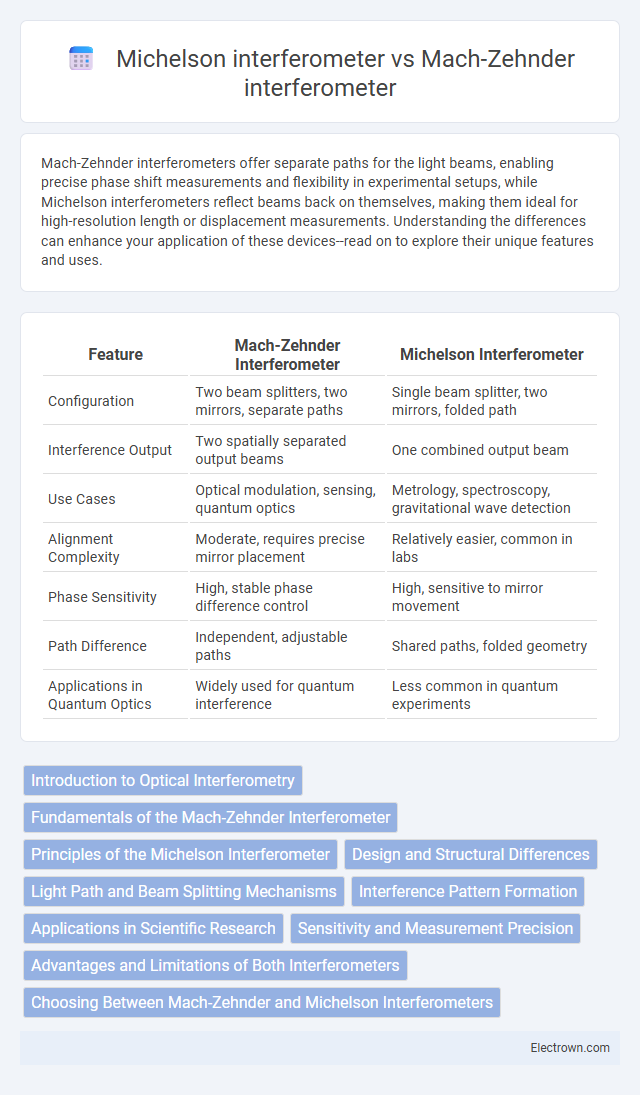Mach-Zehnder interferometers offer separate paths for the light beams, enabling precise phase shift measurements and flexibility in experimental setups, while Michelson interferometers reflect beams back on themselves, making them ideal for high-resolution length or displacement measurements. Understanding the differences can enhance your application of these devices--read on to explore their unique features and uses.
Table of Comparison
| Feature | Mach-Zehnder Interferometer | Michelson Interferometer |
|---|---|---|
| Configuration | Two beam splitters, two mirrors, separate paths | Single beam splitter, two mirrors, folded path |
| Interference Output | Two spatially separated output beams | One combined output beam |
| Use Cases | Optical modulation, sensing, quantum optics | Metrology, spectroscopy, gravitational wave detection |
| Alignment Complexity | Moderate, requires precise mirror placement | Relatively easier, common in labs |
| Phase Sensitivity | High, stable phase difference control | High, sensitive to mirror movement |
| Path Difference | Independent, adjustable paths | Shared paths, folded geometry |
| Applications in Quantum Optics | Widely used for quantum interference | Less common in quantum experiments |
Introduction to Optical Interferometry
Optical interferometry harnesses the principle of superimposing light waves to measure minute differences in optical path lengths. The Mach-Zehnder interferometer uniquely splits a light beam into two separate paths that recombine after traversing different media, making it ideal for phase shift analysis and real-time monitoring. The Michelson interferometer, distinctively configured with a beam splitter and adjustable mirrors, excels in high-precision distance measurements and spectral analysis by comparing reflected beams.
Fundamentals of the Mach-Zehnder Interferometer
The Mach-Zehnder interferometer operates by splitting a coherent light beam into two separate paths using beam splitters, allowing each beam to travel distinct optical routes before recombining to produce an interference pattern. Its design enables precise measurement of phase shifts caused by variations in optical path lengths, making it essential for applications in quantum mechanics, optical sensing, and metrology. You can leverage the Mach-Zehnder interferometer's ability to analyze complex wavefront modulations and environmental changes with high sensitivity and clarity.
Principles of the Michelson Interferometer
The Michelson interferometer operates on the principle of splitting a single light beam into two paths using a beam splitter, reflecting the beams off mirrors, and then recombining them to create interference patterns based on path length differences. Variations in the optical path difference cause constructive or destructive interference, enabling measurements of distance, refractive index changes, and small displacements with high precision. This interferometer is essential in applications such as spectroscopy, metrology, and gravitational wave detection due to its sensitivity to phase shifts.
Design and Structural Differences
The Mach-Zehnder interferometer employs two beam splitters and two mirrors arranged to create two separate optical paths that do not overlap, enabling modulation and phase shift measurement with high stability. In contrast, the Michelson interferometer uses a single beam splitter with two perpendicular arms where beams overlap and interfere upon reflection, making it highly sensitive to path length differences but more susceptible to environmental disturbances. The Mach-Zehnder's open configuration allows for easier insertion of samples into the beam paths, while the Michelson's folded design is more compact but often requires precise alignment and vibration isolation.
Light Path and Beam Splitting Mechanisms
The Mach-Zehnder interferometer uses two separate beam splitters to create two distinct light paths that travel through different arms before recombining, allowing precise phase shift measurements in each arm. In contrast, the Michelson interferometer employs a single beam splitter to split light into two paths that reflect back along the same trajectories, recombining at the beam splitter to produce interference. The spatial separation of beams in the Mach-Zehnder configuration enables easier manipulation of individual arms, whereas the Michelson design relies on retroreflection and co-linear beam overlap for interference.
Interference Pattern Formation
The Mach-Zehnder interferometer creates interference patterns by splitting a beam into two separate optical paths that recombine to produce phase-dependent intensity variations. In contrast, the Michelson interferometer reflects beams back along the same path, forming interference from the optical path difference between the two mirrors. Mach-Zehnder interferometers enable separate spatial manipulation of beams, enhancing control over interference fringe visibility and stability compared to the reflective configuration of Michelson interferometers.
Applications in Scientific Research
Mach-Zehnder interferometers excel in quantum optics experiments, enabling precise phase shift measurements and quantum state manipulation due to their spatially separated beams. Michelson interferometers are widely used in gravitational wave detection and optical metrology, providing high sensitivity in path length difference measurements. Both interferometers contribute significantly to spectroscopy, coherent communication systems, and fundamental physics research.
Sensitivity and Measurement Precision
The Mach-Zehnder interferometer exhibits higher sensitivity and measurement precision due to its separate beam paths, reducing noise and enabling accurate phase shift detection in complex environments. In contrast, the Michelson interferometer can suffer from phase noise caused by common-path disturbances but offers robust precision in stable, controlled settings. Mach-Zehnder configurations excel in applications requiring precise phase modulation and high-resolution sensing, outperforming Michelson setups in dynamic measurement scenarios.
Advantages and Limitations of Both Interferometers
Mach-Zehnder interferometers offer high sensitivity and are ideal for phase shift measurements in complex refractive index materials, with the advantage of separate paths that reduce noise from back reflections. Michelson interferometers provide simplicity and wide wavelength compatibility, making them suitable for precise distance or displacement measurements but are limited by interference pattern stability due to path length fluctuations. Your choice depends on whether you prioritize noise reduction and separate beam paths (Mach-Zehnder) or straightforward alignment and broad spectral use (Michelson).
Choosing Between Mach-Zehnder and Michelson Interferometers
Mach-Zehnder interferometers are preferred for applications requiring separate paths for sample and reference beams, enabling easier manipulation and real-time measurements in fluid dynamics or biological assays. Michelson interferometers excel in precision measurements and surface profiling due to their simpler design and higher stability in controlled environments. Choice depends on experimental needs: Mach-Zehnder for versatility and dynamic studies, Michelson for high-precision interferometry with fixed setups.
Mach-Zehnder interferometer vs Michelson interferometer Infographic

 electrown.com
electrown.com